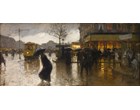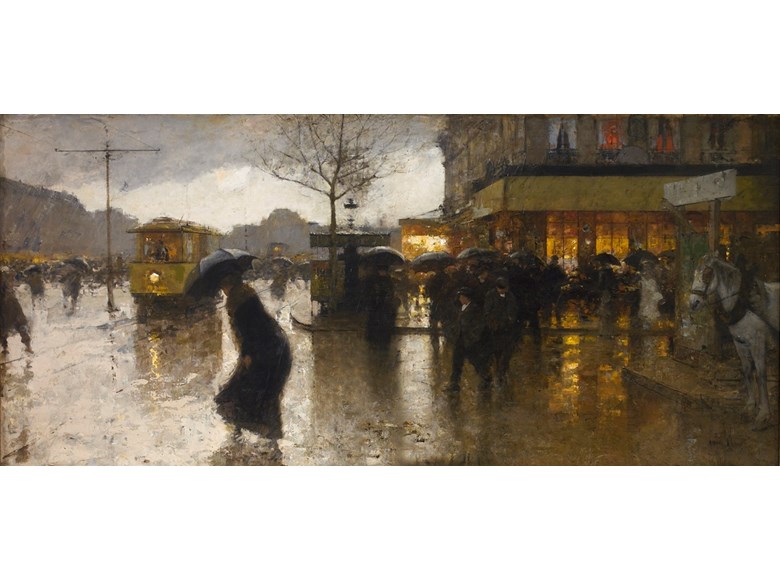 BACK TO GALLERY
BACK TO GALLERY
Lawrence Steigrad Fine Arts
Luigi Loir
Rainy Evening, Paris
signed in the lower right Loir Luigi
34 3/8 x 76 3/4 inches (87.3 x 194.95 cm.)
description
Luigi Loir in one of his most monumental works presents a sweeping view of a Parisian boulevard in the rain at twilight. Dark skies gather overhead with a white horizon in the background. The beacon headlight of an oncoming streetcar shines across the left side of the scene giving warning to a gingerly stepping fur-collared lady crossing in the foreground clutching an umbrella. Behind the streetcar and to its left the torrential downpour has all running for cover. While on the right pedestrians stroll at a more leisurely pace with most under the safety of their umbrellas. Warm yellow lights flare from the shop windows behind them creating a rhythmic pattern of reflections on the road, with the interiors of the apartments above the shops enveloped in a red glow. A white harnessed horse enters the scene in the right foreground. The view encapsulates Paris at around the turn of the century, but Loir has also recorded a city in transition with the self-propelled streetcar representing the future and the horse-drawn wagon the past. Born Aloys François-Joseph Loir to French parents living in Austria, he first studied at the Accademia di Belle Arti, Parma in 1853. Ten years later he moved to Paris, where he enrolled to study with the mural painter Jean Amedée Pastelot (1810 – 1870). Upon finishing his studies in 1865, Loir made his debut at the Paris Salon with Paysage à Villers-sur Seine for which he received high acclaim. Due to his studies with Pastelot, he also became a very popular ceiling and mural painter: one of Loir’s first commissions was to paint the murals and ceilings at the Chateaux du Diable in 1866.
After 1870 Loir concentrated exclusively on painting views of Paris. In these works, Loir caught and expressed the many faces of Paris at all hours of the day. These displayed Loir’s exceptional powers of observation and craftmanship and it is with these that he ultimately made his reputation. In 1879 Loir was awarded the third-class medal at the Salon. A second-class medal followed at the Salon of 1889, as well as a gold medal at the Exposition Universelle in the same year. He was inducted into the Legion of Honor in 1898. Loir’s works formed part of the permanent collections of museums in Bar-le-Duc, Chicago, Minneapolis, Montreal, Moscow, Nancy, Nantes, New York, Nice, Paris, Prague, Rouen, St. Louis and Vienna among others.
After 1870 Loir concentrated exclusively on painting views of Paris. In these works, Loir caught and expressed the many faces of Paris at all hours of the day. These displayed Loir’s exceptional powers of observation and craftmanship and it is with these that he ultimately made his reputation. In 1879 Loir was awarded the third-class medal at the Salon. A second-class medal followed at the Salon of 1889, as well as a gold medal at the Exposition Universelle in the same year. He was inducted into the Legion of Honor in 1898. Loir’s works formed part of the permanent collections of museums in Bar-le-Duc, Chicago, Minneapolis, Montreal, Moscow, Nancy, Nantes, New York, Nice, Paris, Prague, Rouen, St. Louis and Vienna among others.






 SEND AN EMAIL
SEND AN EMAIL
 (212) 517-3643
(212) 517-3643